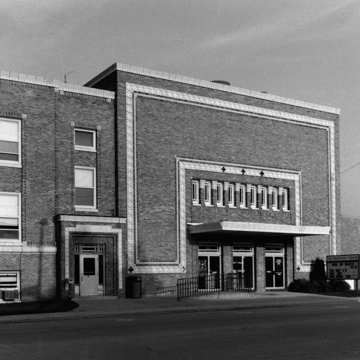In this hybrid city hall and theater, the design and the rich use of terra-cotta ornamentation reflects the influence of Louis Sullivan. Indeed, its design overall bears some resemblance to Sullivan’s Farmers and Merchants Union Bank (1919) in Columbus (CO3). Claude and Starck became known for the finely detailed brickwork found here. While unified by the repeated use of terra-cotta, the building’s exterior expresses its particular functions as city hall and municipally owned movie theater. The theater side, though, is more distinctive. Here, a short colonnade of engaged pilasters with terra-cotta capitals divides a row of Prairie Style windows, which are framed by rowlock and soldier courses and banded by terra-cotta quatrefoils. This band forms a frame around a blank wall of brick. Lining the inner edge of the band, a rowlock course bounds either side of a slender, sinuous terra-cotta molding. To the left of the theater block, an elegant entrance portal marks the municipal office wing. The doorway’s ornate Prairie transom is like a jewel set in brick and terra-cotta bands.
The incorporation of a public performance space in a municipal building had deep roots in the nineteenth century. Fearing that a live-performance theater in Lancaster might fail to attract high-quality entertainment and sufficient audiences to pay for itself, the local building committee decided on the latest in mass entertainment: a movie theater. Claude and Starck created a classical interior, with Composite capitals and ornate swags, garlands, and other moldings originally painted in ivory, gold, and blue. Here moviegoers could spend a few hours in an atmosphere of wealth and luxury while they allowed themselves to escape into the fantasy world on the screen.


